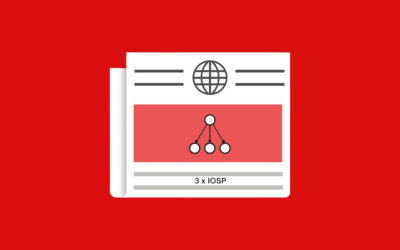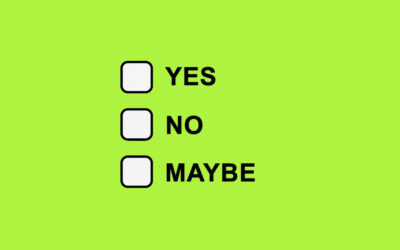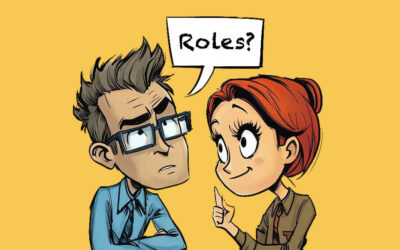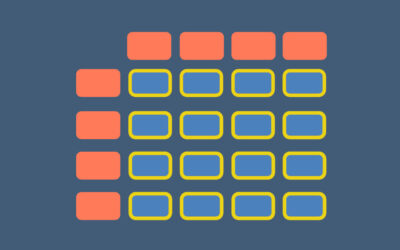A blog for people in organisations.
With useful, first-hand tips from experts.
Forgotten touchpoints in the candidate journey
Many candidate journey concepts end with onboarding. But why is it worth thinking ahead to offboarding, and which touchpoints are important?
Three questions about effectuation
Is effectuation exaggeratedly optimistic, genuinely applicable in practice, and economically even viable? Heiko Bartlog provides answers.
Strategy with the hammer
Many organisations transform structures but do not question the basis of the organisation. Which strategy makes more sense and is more sustainable?
Why don’t employees do what they are supposed to do?
There are reasons why employees don’t do what their superiors expect them to do. How can you identify these reasons and what can you do about it?
Bucket list method: From experience to results
In a changing world of work, people who are reflective, creative and self-effective are in demand. How does the bucket list method help?
AI first – Part 1
Artificial Intelligence (AI) is transforming work. Part 1 of this series focuses on Google’s business model and the future of content marketing.
Get out of your comfort zone. Or get in?
‘Get out of your comfort zone!’ is a well-known mantra. But is it really true? Can personal development and learning only take place outside of it?
Knowledge management in transition: concepts for the future
Demographic change is placing greater emphasis on knowledge management in companies. What concepts help to secure and transfer knowledge?
3 myths that ruin your employee appraisal
An employee appraisal opens up perspectives for both parties and helps to improve performance. But which myths prevent a successful dialogue?
A co-creative approach to risk management
What role does risk management play in times of uncertainty, and what methods and approaches exist for implementing it in a co-creative manner?
When recruiting and specialist departments act in unison
A very important position needs to be filled quickly. How can recruiting and the specialist department work together effectively? A field report.
Corporate vs. personal branding – a comparison with an aha effect
What are the differences between corporate and personal branding, and how can companies combine the two in a meaningful way in practice?
The true cost of outdated software
Why outdated software becomes expensive: risks, warning signs and useful strategies to protect companies from standstills and hidden costs.
Employee appraisal? No, thanks!
Annual employee appraisals are still standard practice in many companies. What is the problem with this and what is a sensible alternative?
Three questions about organisational development
Why is organisational development important, how can it be established, and what role does personnel development play? Jo Kristof has answers.
Master Confusion – the silent strategist in the background
Master Confusion works as a strategist behind the scenes, creating wonderful dysfunction in numerous organisations. Time for a fitting tribute.
A picture is worth a thousand words
Pictures present information simultaneously. How are they used in companies, which notations are helpful and where are the potential dangers?
Jira automation with ScriptRunner
What should you do when the standard automations in Jira fall short and processes get more complex? That’s where Jira ScriptRunner comes in.
Making mentoring effective
Mentoring is a recognised method for the individual development of people in different phases of their career. What makes it really successful?
Agility was just the beginning
Interest in agility is declining in numerous organisations. What are the causes and in which direction is organisational development likely to go?
Three questions about productized services
How to find the right idea and price for a productized service and how it can protect you from bogus self-employment? Maik Pfingsten explains.
Trust destroyers in everyday management
Team trust is not a given. Invisible trust destroyers often cause frustration and conflict without managers noticing or recognising the real causes.
AI and the little white lie
AI applications generate answers and occasionally hallucinate from time to time. However, should companies teach their solutions to lie if needed?
Life-stage oriented leadership
Employees expect flexibility, purpose and a healthy work-life balance – and that also applies to managers. Time for life-stage oriented leadership.
How does real learning work with serious games?
The key to long-term learning is to experience knowledge, not to consume it. What practical contribution can serious games make in this regard?
Inclusive leadership in action
Hierarchical management styles seem to be outdated. What are the benefits of inclusive leadership and how do you become an inclusive leader?
Three questions about the IOSP
What is the Integration Operation Segregation Principle (IOSP), who invented it and why should it be applied? Stefan Lieser has the answers.
Sustainability now more than ever
How do companies that see sustainability as a strategic guideline secure a competitive advantage for themselves, even in a volatile environment?
How often do you take a break?
The art of taking a break is an invisible factor in the success of competitive sports. How can breaks be continuously integrated into our daily work?
From fear to excitement for the future
Many managers and employees are looking to the future with concern. How can curiosity help us to actively shape the future with enthusiasm?
What can the Azure Durable Task Scheduler do?
The orchestration of workflows is a central component of modern software development. How exactly can the Azure Durable Scheduler support this?
Leadership is about directing attention
What does leadership have to do with attention? And what are practical implications for managers, employees and the structures of an organisation?
What makes decisions so difficult?
Do you sometimes find it difficult to make decisions? Perhaps it is psychology that prevents us from making decisions? What can we do about it?
Transfer of knowledge and experience in retirement situations
The imminent retirement of the baby boomers presents companies with challenges in transferring knowledge and experience. What can they do?
Between stress and health
Various factors influence the health of employees. What do the latest figures reveal, what do they mean for companies and what tasks arise from them?
The two faces of self-organisation
Self-organisation is emphasised in many organisations, but what does it actually mean? And why is a differentiated understanding important?
Impulses for organisations – Part 14
More time for self-determined work, hierarchy, power and leadership, and useful alternatives to PowerPoint. 3 new impulses from 3 experts.
OKR pitfalls: Prioritise, but with focus
There are various pitfalls to be aware of when using OKR. One problem, for example, is the loss of focus during the OKR cycle. What tips can help?
Why young and old are stronger together
When old and young meet in organisations, a generational conflict often arises. How can the parties involved really benefit from each other?
What an old Honda says about innovation
Honda’s history shows how innovation is born out of necessity. A journey through time and a description of methods that help with advancement.
Guidelines for company valuation
What are the best methods for company valuation, when is which approach suitable and how can a valuation be carried out with little risk?
Power and self-exploitation
How does power change in organisations when employees start to control themselves and their work? And why is there a risk of self-exploitation?
Goodbye, pressure to succeed
The pressure to succeed usually arises from an inner process that takes place unconsciously within us. How can you recognise and avoid it?
The occupational accident in the company
An occupational accident can happen suddenly at the workplace. What can companies do to minimise risks and how do they prepare for an emergency?
Collaboration with a software partner
When does it make sense to collaborate with a software partner, what practical models are available and which factors can determine success?
Superpower crisis resilience
The ability to overcome crises has become a key skill in today’s world. How can people learn resilience and how can they lead resiliently?
25 events for software developers in 2025
At which events can software developers and software architects find out about technologies and trends? Here you will find a list with 25 events.
6 templates for better collaboration
Good teamwork is an important ingredient for a successful undertaking. Get to know 6 templates that help to improve collaboration in a simple way.
Self-care: no more feeling guilty
Self-care is neither a luxury nor a reason to feel guilty. How can we integrate it into our day-to-day life and what practical approaches can help?
Keep Manager: Everything stays different
The sheer number of changes in organisations is often a major challenge for employees. How can a keep manager help against change fatigue?
Colocation as a driver for digital transformation
What is colocation, why are more and more companies using colocation services and how are they sustainably driving their digital transformation?
Oh, precious books
Are you looking for a selection of books worth reading? Here you will find a compilation of precious books with short interviews with the authors.
The language of appreciation
What does appreciation mean in the workplace and how do you recognise it? And what happens when managers value different things than employees?
Training management in healthcare IT projects
How can a well-thought-out concept improve training management in clinical projects and which modern learning methods are particularly effective?
Slicing Work – Essential skill for agility
Slicing work – the division of labour – is an important skill in organisations and for agility. What types are there and when is each useful?
Three questions about experience level agreements
Do experience level agreements (XLA) replace SLA? How can they be introduced and integrated into outsourcing contracts? Dierk Soellner has the answers.
Farewell as a leadership task
Dismissals are never easy for those involved. This is a guide for managers on how to handle farewells professionally, fairly and empathetically.
Impulses for organisations – Part 13
Lies in companies, the interaction between customers and software agencies, and the challenges of growing companies. 3 new impulses from 3 experts.
Disaster relief as a model for corporate crises
Overcoming corporate crises like disaster relief: What companies can learn from crisis professionals to remain resilient and capable of acting.
Three questions about clean code
What is Clean Code, how can it be introduced and used regularly in a team, and what is its relevance in the age of AI? Stefan Lieser has answers.
Open communication, strong corporate culture
Companies can strengthen their corporate culture step by step through open communication. How does this work in practice and what tips are helpful?
Do we really need this feature?
YAGNI is a well-known principle in software development. You ain’t gonna need it. Do companies really need all the features they want and pay for?
Sense and nonsense of pain points
In marketing and sales, pain points are considered potential sales opportunities. Do people really often buy because they want to relieve pain?
Back to loyal cooperation
Loyalty is a very valuable asset in many companies, but it can easily be lost. How can superiors reinstate loyal cooperation within a team?
Systemic questions: the path to new answers
Systemic questions support the path from problem to solution. What examples are there and what should be considered in practical application?
Form on the day in everyday working life
Companies pay little attention to form on the day. Why is that a mistake, what are the challenges in practice and what approaches are useful?
Value-based leadership: actions over words
Values have great potential when integrated into organizations systematically. How does the implementation of value-based leadership succeed?
Impulses for organisations – Part 12
The consequences of micromanagement, the reciprocal relationship between power and project planning with ChatGPT. 3 new impulses from 3 experts.
Using gamification for SEO
Gamification can help to sustainably improve the user experience on websites. How does search engine optimisation (SEO) work with gamification?
Advance your Product Backlog Refinement
When developing products, the Product Backlog Refinement is often critical to success. What big ideas help to advance the PBR to a different level?
New Work in the classroom
The integration of New Work into the education system offers a promising perspective for the future of schools. What are the success factors?
Is stress good or bad?
What function does stress fulfil? Why do people view stress differently, what role does mindset play and how can we deal with it successfully?
Our world of beliefs
Every person has beliefs. And so does every company. How and when do they come about, what are their functions and how can they be dealt with?
Role-based work in non-self-organised teams
What does role-based working mean, what challenges need to be overcome when collaborating and why does it also make sense in non-self-organised teams?
Delete strategy: Relief instead of overload
With increasing workloads, time management and self-optimisation are considered modern tools. But what really helps is the delete strategy.
Negative self-talk: risks and side effects
What influence does negative self-talk have on our behaviour, what are the foundations of mental imagery and what tool provides a way out?
A personal wiki for project managers
What are the benefits of a personal wiki, how do you build it to gain a good overview, and when does it make sense to create a team wiki?
Using AI for SEO
Is it worth using artificial intelligence (AI) for search engine optimisation (SEO) of your own website and what developments can be expected?
Agile washing
What is agile washing, what benefits do companies expect from it and how can they recognise the demand for true agility in practice?
Impulses for organisations – Part 11
Corporate communication in digital times, tools for systemic thinking and the use and customisation of processes. 3 new impulses from 3 experts.
How the meeting industrial complex hinders value creation
Do organisations need more and more meetings because the world is becoming increasingly complicated? And what does this mean for organisations?
Matrix organisation: formalised irresponsibility
Taking responsibility is a serious challenge at many levels in many matrix organisations. What are the causes and what should companies do?
Courageous leadership with heart
What are the key aspects of courageous and empathetic leadership and how can this create a value-adding environment? A report from experience.
Three questions about e-learning tools
When are e-learning tools worthwhile, what to do in the event of resistance and how to get started with digital training? Nadine Pedro has the answers.
Brainstorming with ChatGPT: creativity with limits
ChatGPT is used in many companies for brainstorming. In which situations is ChatGPT a good brainstorming partner and where does it get stuck?
Layered process audits: company layers in sight
What are layered process audits? What roles do checklists and checkpoints play in the audit? And what distinguishes LPA from other audits?
Stop your agile transformation!
Many agile transformations fail because organisations use the rules of classic change programmes. Why can’t this work and what is a better approach?
Podcast gems: listening pleasure at its best
Are you looking for podcasts about leadership and management, projects and programming, the future or innovation? You can find recommendations here.
Using conflicts in the team productively
In most organisations, conflict is seen as something bad, but this does not have to be the case. How can conflicts be utilised in a productive way?
Content is king for SEO
Content is the key to search engine optimisation (SEO). Why is content so crucial for good rankings and what is good content?
Challenges when replacing legacy IT systems
IT systems always age and at some point they have to be replaced. What are the challenges of replacing legacy IT systems beyond the technology?
Impulses for organisations – Part 10
Focus on employees, promotion and professional passion as well as the impact of personality in companies. 3 new impulses from 3 experts.
7 IT use cases with ChatGPT
How suitable is ChatGPT for typical development tasks? A practical test with 7 IT application examples and recommendations for action.
Sustainability and leadership expertise
Sustainability offers numerous approaches for improving leadership expertise. Why is sustainability so important for managers in general?
Leadership quality number 1: Self-care
Self-care is a important foundation for leadership. It begins with reflecting on how we deal with certain situations. Which tools help with self-care?
The principle of affordable loss
What is the principle of affordable loss? How does it work, when and in what situation does it help and what is special about the principle?
A holistic approach to software efficiency
What is software efficiency? Why is too little attention paid to this topic, which areas does it cover and why should it be considered holistically?
Three questions about uncertainty
How do personal values, cultural differences and new technologies influence how we deal with uncertainty? Astrid Kuhlmey provides answers.
The way back to the corporate office: reasons and solutions
Many companies want employees back in the office after remote work. What are the reasons, and how can this transition be successfully managed?
The concept of integral leadership
Leadership is complex. The concept of integral leadership offers managers different perspectives for thinking and acting holistically.
Self-efficacy as the key to (professional) fulfilment
Self-efficacy characterises our thoughts, actions and feelings. It is an essential ingredient for our success. And it can be developed!
Misunderstood agility
Agility is often seen in companies as a miracle cure to solve many problems. Unfortunately, the actual goal of agility is misunderstood.
How does value-adding offboarding work?
Many companies do not have a well-developed offboarding strategy and thus miss the opportunity to benefit from the experience of their employees.
The effectiveness of agile coaching – Part 2
One aspect of agile approaches is the assumption of responsibility by teams. How does team responsibility enhance Agile Coaching effectiveness?
Contradictory KPI in online marketing
The use of KPI in online marketing is widespread, but often aspects are measured that allow more than one interpretation and are thus contradictory.
A journey through the new world of work
The perfect job is not something you find, but something you create. And how do you achieve this in the new world of work? A field report.
Impulses for organisations – Part 9
Psychological security and the pursuit of harmony, why deterrent recruiting is important and how true learning succeeds – 3 new impulses from 3 experts.
The effectiveness of agile coaching – Part 1
Companies often argue about the effectiveness of Agile Coaching. How does the discussion work and why is it not effective?
Oh, books worth reading
Are you looking for books worth reading? Here you will find a selection of books with interviews with the authors, each answering three questions.
Asking the right questions when testing AI systems
Do we still need testers in the development of AI systems? And what questions do companies need to answer when testing artificial intelligence?
Tool-supported test design: A plea
The quality of software tests depends on the test design. What is the status of tool support and what does the discipline of test design need?
The Inner Development Goals
Change often entails altering behavior. What’s the role of Inner Development Goals (IDGs) in this? Why are they relevant for managers and employees?
Three questions about job adverts
How does my job advert stand out from the competition, how do I avoid whitewashing and should I use gender language? Madeleine Kern has answers.
Experience Level Agreements (XLA) – Part 2
Which frameworks for Experience Level Agreements (XLA) do IT service providers use? What requirements exist and what are the advantages?
Organisations develop by themselves
It is normal when tried and tested methods suddenly no longer work. What levers help to develop a sustainable organisation?
Cybersecurity: more than just a protective shield
Cyberattacks are a real threat to all kinds of organisations. Why is cybersecurity important beyond the use of technology and employee training?
Three questions about digital transformation
Enthusiasm, relevant skills and personal health are important aspects of digital transformation. Sandra Brauer provides interesting perspectives.
Experience Level Agreements (XLA) – Part 1
What is an Experience Level Agreement (XLA), what is the difference between SLA and XLA and what does XM address? A clarification of terms.
The variety of shared leadership
There are a number of terms associated with shared leadership that are not used consistently. Time for a definition and a few practical questions.
Design thinking, domain storytelling and API design
Design thinking and domain storytelling are considered to be useful methods, but do they help programmers in the design of application interfaces?























































































































